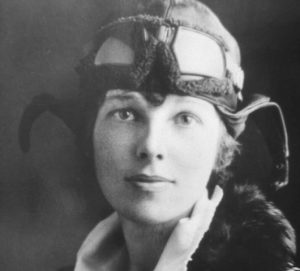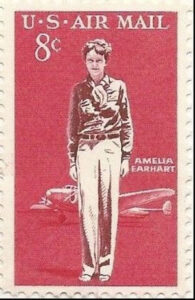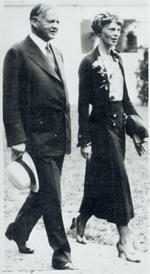Exclusive
Special to WorldTribune
Robert Morton, September 30, 2025 Real World News
“It was the time of the Cold War, and every corner of the earth was considered a possible battlefield,” recalled a former CIA official about his years based in the Micronesian Islands. Sheer boredom led him to inquire about inquire about Amelia Earhart.
“Washington felt it had to know everything about everything. It was a do-nothing job. The islands were small enough to spit across. So, for the most part, there was little to do.”

“I took it easy, drank beer on make-shift beaches and watched the natives.”
In 2015, the retired official contacted WorldTribune.com at the suggestion of the late contributing editor Sol Sanders. He wanted to at last publish a four-part series written years earlier about what he had learned of Amelia Earhart’s final days based on his friendship with a priest and subsequent research while living in the islands.
Subsequently WorldTribune.com arranged for a videographer to conduct an interview at his home.
Spooked by that experience which included bright lights, he later called to say he had reconsidered. He apologetically requested that his articles not be published. A few months later, he passed away.
Out of respect for his wishes, those articles and video tapes have been preserved but never published.
Earlier this week, President Donald J. Trump posted the following
“I have been asked by many people about the life and times of Amelia Earhart, such an interesting story, and would I consider declassifying and releasing everything about her, in particular, her last, fatal flight! She was an Aviation Pioneer, the first woman to fly solo across the Atlantic Ocean, and achieved many other Aviation ‘firsts.’ She disappeared in the South Pacific while trying to become the first woman to fly around the World. Amelia made it almost three quarters around the World before she suddenly, and without notice, vanished, never to be seen again. Her disappearance, almost 90 years ago, has captivated millions. I am ordering my Administration to declassify and release all Government Records related to Amelia Earhart, her final trip, and everything else about her. Thank you for your attention to this matter!
“DONALD J. TRUMP, PRESIDENT OF THE UNITED STATES OF AMERICA”
The following is based on the CIA official’s account, which cannot be readily verified as both he and his primary source, the priest, are deceased. Also, the native women whom the priest said had identified Earhart from photos he showed them are dead. They “soulfully” told him Earhart had died while in their care (he concluded of dysentery), and that the cemetery where she had been buried had been destroyed by U.S. artillery before the American forces overwhelmed the Japanese troops occupying the islands.

On July 1, 1937, Amelia Earhart, accompanied by her navigator, Fred Noonan, “began the most dangerous leg of her journey from Lae, New Guinea, to Howland Island, a tiny dot in the ocean, 2556 miles away,” he recounted.
“Even though Amelia had not received Japanese permission, she lifted off from Lae at dawn in her Lockheed Electra. The plane was heavily laden with gasoline to make the long, non-stop flight to Howland where she was scheduled to arrive at 8 a.m. the following morning, a flight of about 27 hours. She was never heard from again.”
At one point, out of sheer boredom, the official decided to make inquiries about Earhart. “Mostly, I received a blank stare, or at best, “Amelia? Who’s that?” I was getting nowhere. Soon I just gave it up.”
Later he met a priest while having lunch at a Japanese honeymoon hotel in Saipan. “I say a honeymoon hotel because it was just what it was. The cost of getting married in Japan was exorbitant.” Better to fly to Saipan and stay at a luxury hotel at less expense and more fun.
He picked up the check because the priest “didn’t have pocket money to speak of. Whatever he had went into something for the Chomoros whom he sincerely loved and cared for as best he could. He even spoke their language, which was a mixture of their native tongue and Spanish.”
In subsequent meetings he asked about Amelia Earhart, and the priest confided that he knew about her and her death.
“He started his story saying Amelia’s plane came down or crashed in probably the western reaches of the Japanese-fortified Marshall Islands. She was off-course but in 1937 navigational equipment was not that good. She and Noonan were taken prisoner and accused of being American spies.”

He explained that Saipan was the seat of government of the Japanese South Seas government and any felony offense, calling for imprisonment for two years or more, required the accused be brought to Saipan for trial. And thus, Amelia Earhart and her navigator Fred Noonan were transported to Saipan. Two days later, he said, Noonan was executed within earshot of Earhart’s cell.
She was taken to the Garapan Hotel where she was locked in the room where she would spend the rest of her life. An old Christian woman, one of several who were ordered to care for her, was reluctant to discuss Earhart’s demise but based on her spiritual bond with the priest, ultimately confided in him.
“We brought food to her and fed her. We washed and cleaned her. . . She was thin . . . so thin.”
“What happened to her?” he asked.
“She died,” the woman said, “long ago, before the war. We buried her in the Cemetery of the Angels. . . . Not the cemetery you see. Not that one. That’s new. The old one was destroyed by the American ships.”
Some time later, the woman arranged for four or five of her friends who like her had taken care of Amelia to meet the priest. “He came well-armed for the meeting. He brought four photographs of American women taken in the 1930s. One of the photographs was of Amelia. He gave the photographs to each woman, individually, and when she had finished, passed them to the next. When they all had finished, he asked them to tell him which photograph was of the white woman in the hotel. Each of them independently pointed to the photograph of Amelia. They did not talk about it among themselves first.”
Why did the priest reveal what he clearly regarded as a secret reluctantly and painfully revealed to him by his parishioners?
“I think he told me Amelia’s story because a secret is a heavy burden to bear. Its weight grows with time, and there is a burning desire to tell someone, to pass the truth along, not to die possessed of a smoldering secret.”
Support Free Press Foundation
